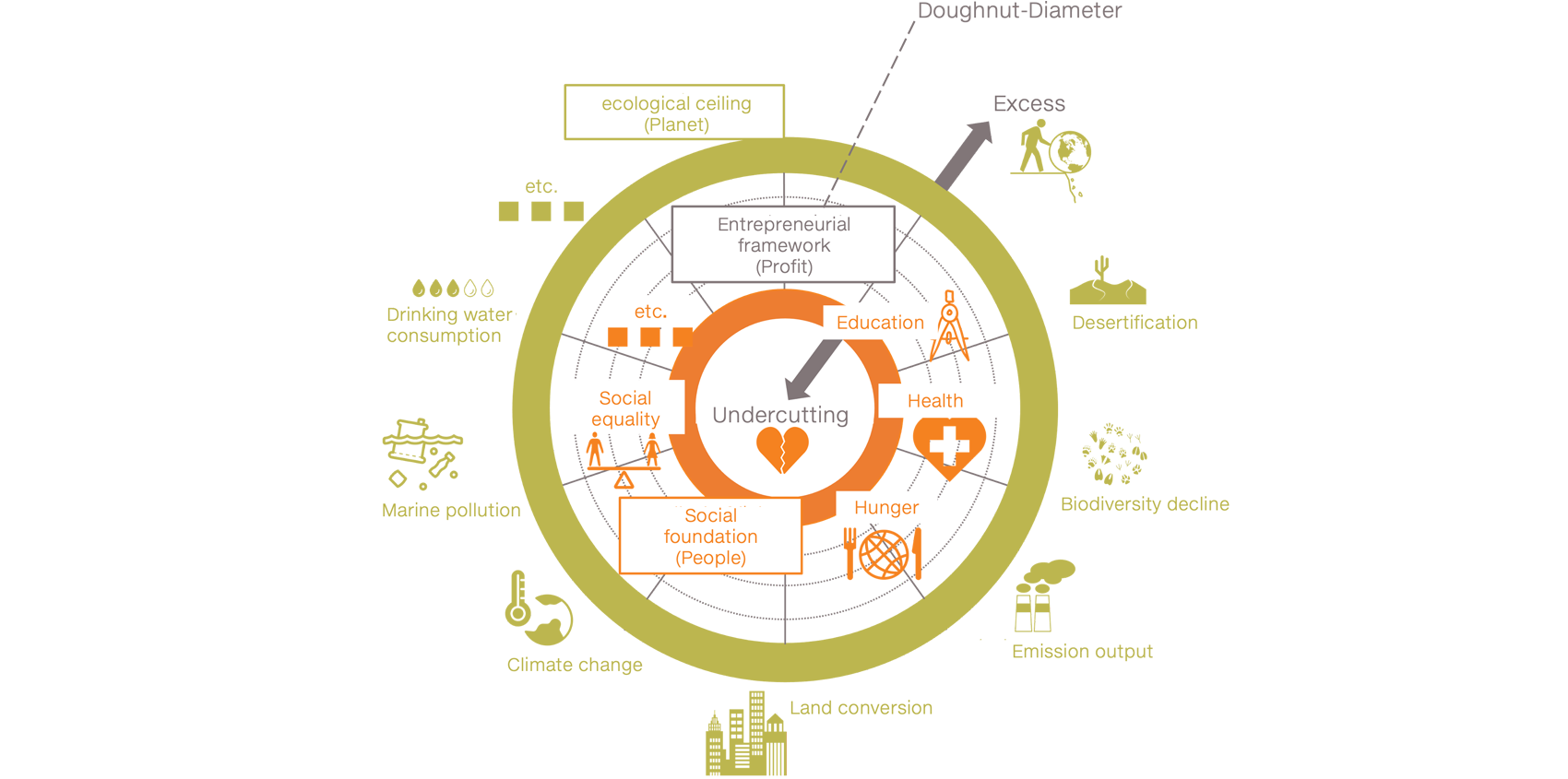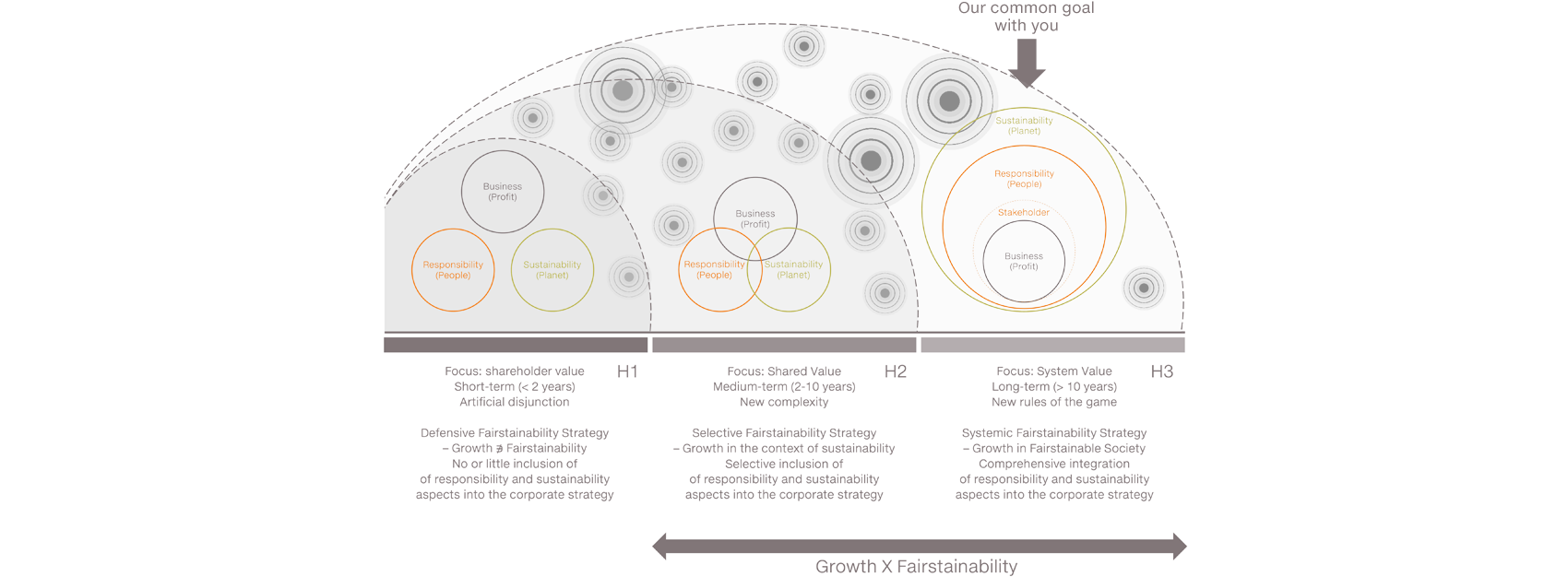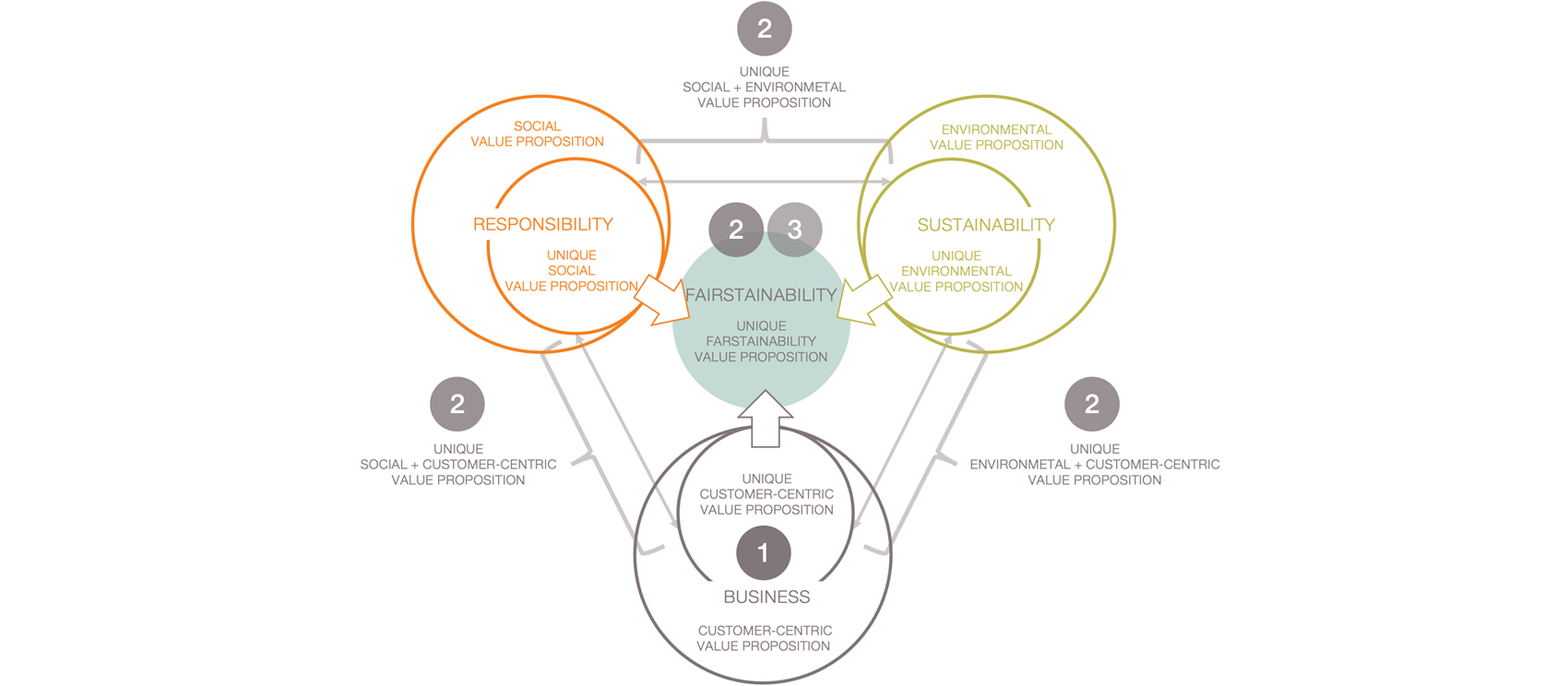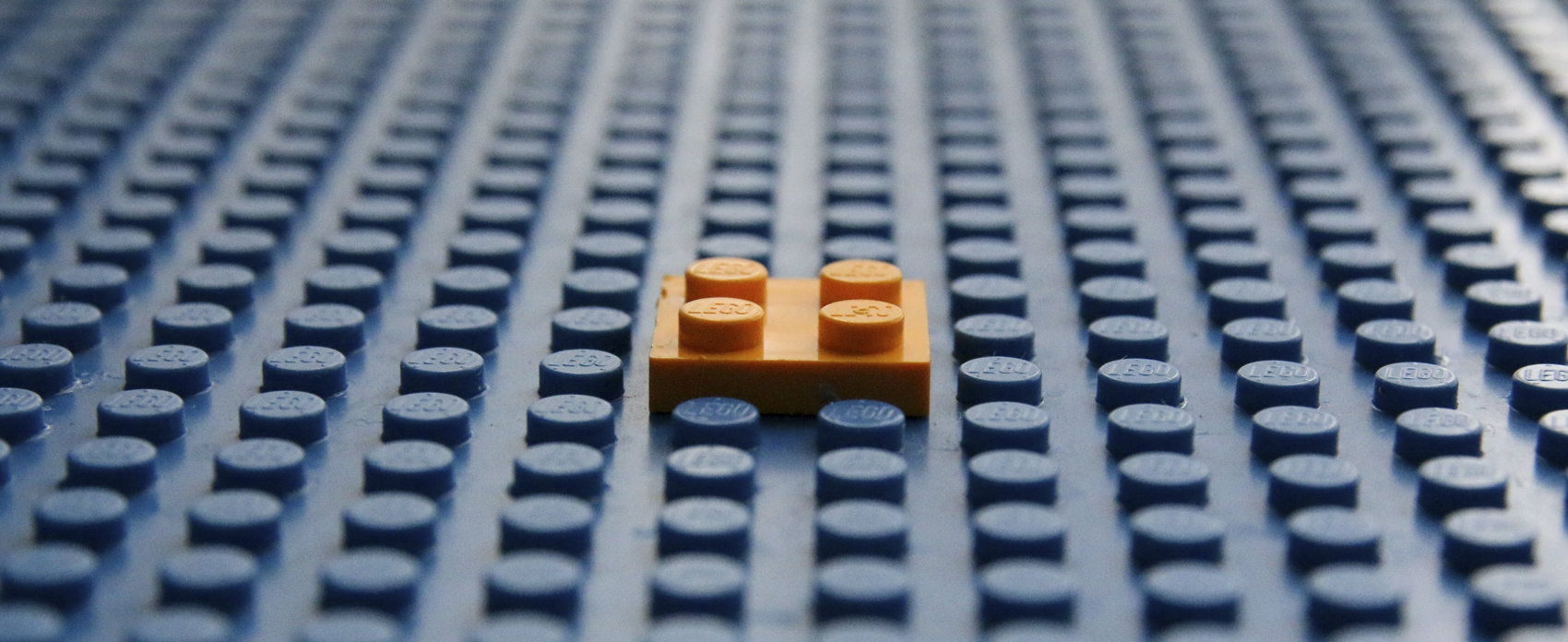DRIVEN BY FAIRSTAINABILITY
IT IS ALWAYS BETTER TO SHAPE THE FUTURE THAN TO LET IT SHAPE ME.

The current and future management scope for shaping and implementing growth strategies is determined by the donut economy. The diameter (i.e. the foundation) is the span between the outer ring – the ecological upper limit – and the inner ring – the social foundation – is becoming smaller and smaller. The main reason is international and national legislative amendments..

WE ARE AT THE BEGINNING OF AN UNSTOPPABLE DEVELOPMENT PROCESS.
The development towards a fairstainable society takes place in waves, stimulated by economic and socio-political developments, megatrends and regulatory requirements.
These developments, which initiate oscillations as impulses, drive the wave-shaped development towards a fairstainable society.

Currently, companies, society and the environment are still largely separate systems. Accordingly, a company can be economically successful and at the same time have massive negative but legal effects on society and the environment.
In times of EU taxonomy and other regulatory developments, there is a slight partial convergence of the three hitherto disjoint systems. Accordingly, from a simplified point of view, companies are no longer allowed to have a negative impact on selected social or environmental KPIs (e.g. CO2 emissions). Concerning all other limits of the donut economy, companies are still allowed to act against – permitted by law.
In planning horizon H3 the (economic) world looks quite different. In this phase, a company is no longer allowed to have any negative impact on any social and ecological goal, wich means: no negative emissions, no negative impact on biodiversity, no negative effects on the health of all employees in the entire supply chain, etc.
The challenge now is to anticipate this development and to transform your corporate strategy, your innovation management, your products, your production processes accordingly.
We accompany you in developing a two-speed transformation approach, creating immediate value while developing initiatives for the future.
According to the three phases or planning horizons (H1–H3), your unique value proposition will also change over time. In the end, the companies that will succeed are those that generate a unique value-added combination of customer-centricity and social and environmental added values.


INTERTEMPORAL ANALYSIS
The aim of our analysis, the INTERTEMPORAL ANALYSIS, is to analyse the company's past and current ability of fairstainability. Accordingly, the INTERTEMPORAL ANALYSIS consists of a PAST FORWARD ANALYSIS and a PRESENT NOW ANALYSIS.
Only if on the one hand lessons are learned from possible mistakes in the past and on the other hand the current ABILITY OF FAIRSTAINABILITY is determined, strategies, concepts and measures can be developed and implemented purposefully, and thus fairst, through which fairstainability becomes the engine for growth.
SHAPE YOUR PRESENT AND DEFINE YOUR FIRST STEPS INTO THE FUTURE BY ANALYSING YOUR PAST AND YOUR STATUS QUO.
One analysis moves towards the past. The other analysis looks at the status quo. By communicating, the development of strategies is possible – but without considering the future. The future is still considered as a variable that determines strategic action, and not vice versa.

WHY THE PAST FORWARD ANALYSIS?
The Past Forward Analysis (PFA) is only carried out together with the Present Now Analysis (PNA) and usually only for selected strategic decisions from the past. Why? Because the present is trapped in the past.
The PFA serves as a basis for defining how the transformation can be carried out most effectively.
It answers the questions:
- Why have the selected goals not been achieved so far, although they have been identified in the past?
- Why we did successfully implemented initiatives succeed and how can the factors of success be replicated for further initiatives?
RESULTS
- Lessons-learned list that are clearly defined don'ts and do's
- Recommendation on how to build a successful framework for the transformation of the company
WHY THE PRESENT NOW ANALYSIS?
The Present Now Analysis (PNA) forms the basis for the development of reactive growth strategies whose driver is fairstainability and the associated corporate transformation.
In this case, the future is regarded as a variable that determines strategic action and cannot be influenced by the company.
Depending on its modular design, the PNA answers the questions:
- Which of the sustainability and responsibility goals (Future-Fit Break Even Goals ⎼ BEG) were already archieved? Which bring the greatest financial benefit?
- How are the company's sustainability ambitions implemented today (strategy, culture, organisation, production and operations, marketing and sales) according to the German Ethics Index?
- What is the set-up for fairness reporting?
- What is the ecological sustainability status of the technologies used?
RESULTS
- Ability of Fairstainability
- Prioritised high-level gap analysis by BEG (people and planet)
- High-level initiatives by DEX metatool (profit)
- Status quo of sustainable finance (performance)
- High-level status quo report on the status of technology (progress)
- High-level assessment of added value by prioritised BEG
- First definition of reactive fairstainability strategies
THE 5P-MODEL
The anaysis is based on the 5P MODEL developed by us, which enables a 360-degree analysis of the Ability of Fairstainability. The structured, focussed, comprehensive and modular analysis tool makes it possible to set company-specific focal points, and is particularly suitable for medium-sized companies to develop a well-founded starting point for the status quo of the STRATEGIC FAIRSTAINABLE TRANSFORMATION.

The phase of analysis lays the ground for the foundation for developing goals, strategies and business models that positively influence both the TOTAL FAIRSTAINABILITY IMPACT and the TOTAL SHAREHOLDER RETURN.
Are you reshaping your future or is the future reshaping you?
If the starting point is the INTERTEMPORAL ANALYSIS, then strategies and concepts are developed on the basis of the assumption that the future is a given for the company under consideration and can only be influenced by the company itself to a very limited extent. Well-founded strategy development thus encounters an increasingly dynamic future. The future is reshaping you!
However, if the INTERTEMPORAL ANALYSIS is expanded to include a FUTURE BACK DESIGN completely different opportunities arise for a company, for the INTERTEMPORAL ANALYSIS now becomes INTERTEMPORAL SHAPING. A wellfounded strategy can now be derived from the future you have created yourself. You shape your future anew!
SHAPE YOUR FUTURE ANEW! INTERTEMPORAL SHAPING
One analysis moves towards the future. It sees what is coming soon. The other approaches the past, explaining once more what was. The third looks at the present, unmasking the status quo. By communicating all of them, they short-circuit time. A present manipulated in this way leads to an alternative future shaped by the company.

WHY THE FUTURE BACK DESIGN?
The Future Back Design (FBD) provides a common view of the future of the industry in which a company operates. Each FBD is individually adapted to the respective customer, its environment and possibilities.
In the FBD you develop your relevant future, you design your future and you define how competitors will have to follow you in the future. The FBD is the basis for developing formative, active and marketinfluencing strategies and thus for future first-mover business models whose engine and context is fairstainability.
It also serves to review your current strategy for its future orientation and to develop a portfolio of initiatives that enables you to address the future today. Future Back Design, Present Now and Past Forward analysis intertwine to enable the development of proactive growth strategies.
FBD combines two essential components that determine the future.
1. Societal, technological, cultural and political megatrends with

2. The predictable development towards a fairstainability society and the associated requirements for responsibility and sustainability – in other words, fairstainability

In our workshops you develop your relevant future and then define, the stepstones to successfully arrive to the future you have developed.
Result
- Trendcloud: Assessment of the relevant trends
- Actual positioning in relation to the trends
- Company-specific future matrix with the developed, designed and evaluated futures on different time axes
- The Innovation Model Canvas develops the necessary skills and innovation ideas to master the configured relevant future scenario
- The Business Model Canvas, as a top management tool, develops clear initiatives to prepare the company for the future
- Initial definition of proactive fairstainability strategies
INTERTEMPORAL ANALYSIS VS. INTERTEMPORAL SHAPING?
IT DOESN'T MATTER ... NO!
BE SHAPED
Predictable classical environments lend themselves to positional strategies based on advantages that were gained by economies of scale, differentiation or those achieved by special capabilities, and realised by analysis and planning.
Adaptive environments require constant experimentation, is not possible within rapid change and unpredictability
SHAPE
In a dynamic environment, the companies that are the first to create a new market or reshape an existing market will win.
In a formative environment, companies can (collectively) (re)shape an industry to their advantage by orchestrating the activities of other stakeholders.
CONCLUSION
Developing a fairstainability society and the multitude of potentially relevant megatrends requires a profound and comprehensive fairstainability transformation (mindset, strategy, culture, organisation, production and operations, marketing and sales). Those who do not set the course for a strategic fairstainability transformation today will not have the time they will have lost.
INTERTEMPORAL SHAPING is suitable for proactive companies that have already actively shaped their future in the past and want to continue in the future.
But even if developing a fairstainable society seems to be the 5. industrial revolution for a company, it should pick up the momentum to develop new strategic options with the help of an INTERTEMPORAL SHAPING approach.

We are happy about difficult questions, sporty timings, nice mails and new contacts. We talk, email, zoom or even meet with you in person. Whatever moves you, we are happy to listen.
